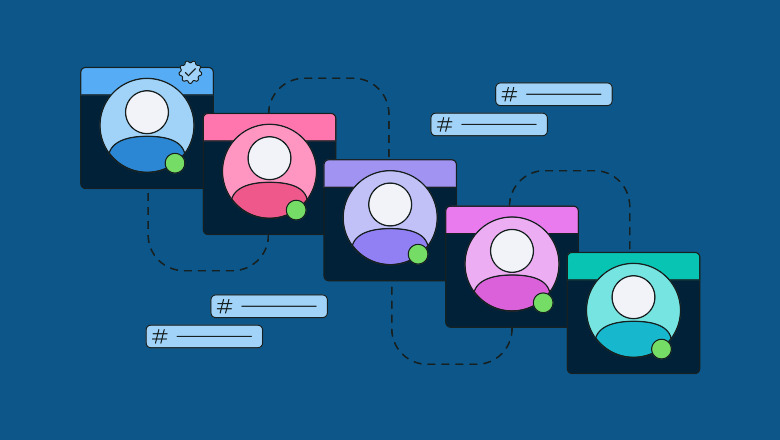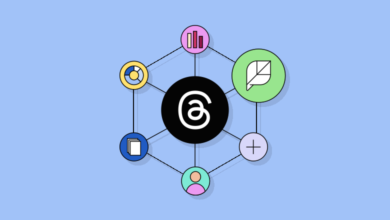Is the Discord community right for your brand?
Discord is the future of online communities.
Traditionally associated with gamers, this platform has become mainstream.
Today the seven year old company has over 300 million registered users.
Discord adoption is part of a much broader trend. Gen Z, in particular, is choosing to spend time in small, private online communities.
According to Harvard Business Review, “…Even before Covid-19, Gen Zs were abandoning traditional social media for ‘digital campfires’, more intimate online destinations where they could share private messages or micro-communities or larger shared experiences.” Joins.”
Marketers, creators and community builders looking to future-proof themselves should take some time to reflect on themselves – are you part of that “digital campfire”?
The answer is likely… no.
So, how do you get started and what role should Discord play in your audience engagement strategy?
What is Discord and what role does it play?
Discord is not a traditional social media platform. This is not a place of organic growth and awareness. Instead, it is a community forum.
A Discord server is a hub. Its driving objective is to deepen relationships with existing, hardcore fans and campaigners.
This distinction is important.
Brands on Discord should focus on two things. First, to provide experiences that are unique and cannot be replicated anywhere else. Second, relationships and interactions between community members should be facilitated.
It is this deep understanding of the community in which brands such as StockX, Skittles and Chipotle draw on the platform. “Customers are looking for more engagement, more dialogue, more input – and Discord is one of the platforms that offers this,” explained Dina Bahri, StockX CMO, in Adweek.
The most active Discord servers have 24/7 chat across multiple channels. The speed at which conversations take place within Discord is much faster than other platforms.
Users participate in chats, make video and/or audio calls, share screens and direct messages to each other. Topics within a Discord server are organized around “channels,” which ensure conversations are focused and easy to navigate.
All this to say, setting up a Discord community may require more attention and investment to reach fewer people. However, there is a tradeoff. Those people and that community (when cultivated carefully) will create a deep connection with your company. Discord allows a two-way interaction between the brand and its community, making them feel like they are part of the organization – not just the end customer.
How do you set up a Discord server?
To start a new Discord server, click the plus sign below the server icon on the left side of the screen.
From there you can create a server from scratch or choose a template.

The templates give you a list of channels to start with, which you can edit if you wish.
Once you’ve selected your template (or lack thereof), you’ll be prompted to choose your server name and upload an icon.

congratulations. You now have a Discord server.
After you’ve created your server, you’ll need to create channels.
There are two types of channels: text and voice. Text is for all written and image-based conversations, while voice can be voice and/or video.
Regardless of the type of channels you create, you want them to be centered around the interests of your community. This is where community members will gather to chat with you (and with each other) about chosen topics.


To ensure that you cultivate a welcoming community, you may want to create a rules page for new members. You can also create and assign roles to members of your community. Roles determine the member’s admin permissions and as the community expands you can assign moderator status to your trusted users.
Regardless, these are details that you can refine and refine over time.
How do you nurture a discord community?
Great communities start out as small communities.
It’s counterintuitive but true. With Discord, specifically, it’s all about depth versus breadth. Especially, when you are starting out. Here are three tips to consider when building and engaging your audience on the platform:
1. Identify Your Inaugural Classroom
You might want to select the initial members you want to add to the community. Or, at least limit the initial number of members. This will allow you to refine your community management process and remove any disturbances.
So who should join in the beginning?
Do you have ardent fans of your brand? Who is regularly commenting on your social posts or creating content that promotes your brand?
These brand promoters make ideal members. They will be excited about this opportunity.
2. Plan Your Content (and Conversation Starters)
Now that you’ve found your initial community, it’s time to activate them.
Ask yourself, what access and/or exclusives can you provide?
Inspire community activity by motivating (and maintaining) conversations within your servers.
Develop a content calendar to ensure a steady drumbeat of activity and discussions. Ideally, surprise and delight your community so that they feel they are spending their time wisely and have a reason to keep coming back.
Maybe your CEO or founder is praised by the community. Perhaps your brand has a big personality or influential ambassador. Any of these would make an exciting AMA.
Exclusive first looks on products will also give a big boost, and provide an opportunity to garner valuable consumer feedback before a big launch.
You’ll want to focus on activities designed to spark a higher level of engagement. Build momentum through a steady drummer of activity. Remember, it takes time to get used to a community.
3. Test and Learn, Then Loosen the Rule
During the initial stages of developing a community, most activities will need to be motivated by you. Invest in fostering relationships with these early members. Get feedback and identify what keeps them engaged. Apply their input and test what works.
Ultimately, all this is being done to ensure that the community is a worthwhile experience when you scale.
Once the community finally reaches a critical point where most of the conversation isn’t being driven by you, it’s a sign to start adding more members and scale.
If your brand has accomplished this, you’ve really developed a meaningful Discord community.
Is it worth it? Should your brand invest in growing the Discord community?
Ultimately, it depends on your goals as a brand. An apt analogy would be comparing Discord to a house party. This is a private and intimate matter. Whereas Facebook, Instagram or Twitter is like a Vegas nightclub – a place to see and be seen.
Sure, they are both sides, but they are very different experiences.
If you are looking for a platform that will help you grow your audience quickly, Discord is not the place to be. But if you have the resources to invest in building a long-term community of people who can grow and advocate for your brand, then Discord is the right place.
“Spectator” and “community” can no longer be used interchangeably in the social world. Read more to know the reason.
Post Is the Discord Community Right for Your Brand? Sprout appeared on Social for the first time.






